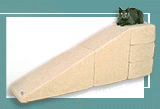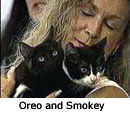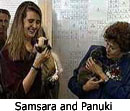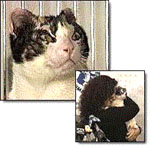vol1 No37
Table of Contents
Assist Feeding – The Different Ways to Feed
Feline Nutrition – Cupboard Secrets
Pro-Active Cat Care – Dis ‘n’ Dat
Feline Obesity – Preventing Injuries
Kitty Potpourri – Scarlett, Hero Cat of the Century!
Assist Feeding – The Different Ways to Feed
by Kathy Fatheree
The following article is a reprint from Vol 1, No 2. Kathy will be back next week after getting settled from the big move.
The first time I ever heard about feeding a cat with a syringe, it was called “Force Feeding.” Perhaps it was called this because the cat is generally not all that keen on the idea. This term doesn’t exactly evoke nice images, and over the years the term eventually became known as ”Assist Feeding.” Assist Feeding can mean any time we are helping our cats obtain the nutrition needed to survive, regardless of the method of food delivery.
Different Ways to Assist Feed
Spoon Feeding. This works with some cats because of their sense of obligation to you. They want to please you, so they will lick canned food off of a spoon. The extra attention your are providing during this personal time may encourage a cat that is not feeling well to eat. If your cat will eat the full caloric requirements, this method will work for you. Ask your vet how much food you need to feed to maintain your cat’s weight.
Finger Feeding. Some cats will lick food off of your finger… the personal touch. Or, try placing a small amount of food directly into the mouth. This may stimulate your cat to eat on his own. It is sometimes hard to get food into a cat’s mouth, if so try this: Gently pull the head up like your are going to give a pill and then with a finger of canned food, scrape a little food off using the cats top front teeth. We call this ”priming the pump.”
Syringe Feeding. Syringe feeding uses a plastic syringe to squeeze the food into the side of the mouth. The tip of the syringes vary depending on type: they may be tapered, blunt, or curved and tapered. Depending on you and your cat, it may take several feedings to get the hang of it. Syringe feeding works best if you can feed your cat at least 3 times per day. We will talk about different syringes in a future newsletter.
| Orogastric Tube. If you cannot be home to Syringe Feed your cat, you may consider day boarding and allowing the clinic to feed your cat during the day by using an orogastric tube. An orogastric tube is a temporary feeding tube placed down the throat and esophagus and into the stomach at the time of feeding and then immediately removed. No anesthesia is required. The tube is sometimes lubricated for ease of placement and feline comfort. This type of feeding is meant to be used as a temporary solution and must be performed by your vet. The value of this type of feeding is that you can get the full daily caloric requirements into your cat. Your cat may start eating on his own after a few days of this feeding. This type of feeding is also beneficial if you need to build the cat’s strength up before surgery. |
Note: Feeding via an Orogastric Tube has been around for 30 years; however, it is not common practice and your vet may not be familiar with this technique. It’s all too easy in today’s world just to surgically place an eTube. Read more about Dr. Norsworthy and orogastric tube feeding.
Surgically Placed Tube Feeding. There are several types of tubes that can be surgically placed when any of the above methods are not an option. As with all surgery, there is a risk… a chance that your cat may not survive the operation. Tubes have saved lives though, so please talk to your vet about your cat’s health and what your options are. The different types of tubes have varying risks associated with them. The three most common tubes are: nasoesophageal tubes (through the nose), esophagotomy tube (eTube), and Percutaneous Endogastric tube (PEG tube). The PEG tube is the most invasive and risky procedure. If your vet recommends a PEG tube, please ask if an eTube would work.
Feline Nutrition – Cupboard Secrets
by Garry White
You’ve heard me expound on the benefits of feeding our kitties the best food possible, and you know that my guys eat mostly holistic foods these days. You also know I’m not fond of naming-names, but in the interest of sharing worthwhile information, I’m going to break one of my own rules: With a disclaimer, I’m going to tell you specifically what foods are stocked in the cupboards here.
DISCLAIMER: By offering the brand-name information below, I do not attest or suggest that these foods are ideal for your cat. Further, the names below do not imply or infer that other brands are inferior; these are merely foods that I have researched extensively, and foods I have chosen to feed my own cats. Additionally, I have no affiliation with any of these companies, in any way.
That said, here we go:
DRY
Solid Gold. Katz ‘n’ Flocken. This is their primary food, mixed lightly with IAMS Lamb & Rice on occasion.
CANNED (Remember these are treats, not meals)
-
- Triumph. These are low-magnesium foods: Trout Formula, Beef/Liver/Bacon Formula, and Beef Stew Formula.
-
- Wellness. Salmon & Trout, and Chicken & Lobster
-
- Purina Pro Plan. Turkey & Giblets Entrée and Ocean Fish & Crab Entrée
-
- Nutro. Veal Pate’ and Hunter’s Stew with Venison
-
- Nature’s Recipe. Rabbit & Rice
-
- California Natural. Venison & Brown Rice
-
- Chicken Soup Brand. Adult cat-light formula
-
- IAMS. Beef Formula and Turkey & Giblets Formula
-
- Felidae. Chicken & Rice in Chicken Broth
-
- Science Diet. Seafood Recipe and Liver & Chicken Recipe
-
- Evolve. Ocean Fish (w/brown rice, carrots, cranberries, and flaxseed) and Chicken Recipe (same other ingredients)
-
- Max Cat. Alaskan Halibut & Rice, Beef Ragout, Seafood & Tomato Bisque, and Chicken Cacciatore
-
- Friskie’s. Sliced Chicken & Gravy
- 9-Lives. Sliced Veal & Gravy
Once again, I am not endorsing these foods beyond statements of experiential success. Most of them are, to the best of my research and knowledge, pure foods made with human-grade ingredients. With the exception of two brands, none have by-products as a primary ingredient. There may be other foods of equal or better quality, but this is our list, and it will probably expand over time. Since adopting this regimen, my two guys seem to be in good physical health, their coats are shinier, they’re slim & trim, and Clark (an older cat) is more active and playful than he’s been in years.
I’m aware of the claim by some that “Cats shouldn’t have variety”, but I don’t subscribe to the opinion. I call it an opinion, because many vets say it makes no difference, and clinically it shouldn’t. One final statement: While I believe in this routine, and my guys seem to love the variety, I will.at the very first sign of a problem.make immediate changes. But until then, my guys get to enjoy mealtime.
ProActive Cat Care – Dis ‘n’ Dat
by Garry White
Oh, woe is us! We’ve been stung by the Computer Gods once again! I wrote that little story last week about Putney and Daisy as a surprise for all of you, and the surprise was on us! The software said: “Yep, that link to the second-page works just fine.go ahead and publish it.” So Kathy did, and on Wednesday nuttin’ happined. Boo-hoo-hoo.WAHHH! However, I’m quick to get over things like this. For example: My first divorce was crushing; nearly killed me! But the last one (#5 or #6 – I’m not all that good with numbers), was like missing lunch at O’ Charlie’s. So I’ve put the whole story about Daisy and Putney together, and you can read it by [CLICKING HERE]. Hopefully.
********************************
I encountered a situation recently, with a lady whose own situation rang a few bells. She has two cats, one of which she’s had for a long time and loves dearly. The other has been with them for only a few months, and he came from a kennel. Her original kitty is loveable, warm friendly.the new cat is reclusive, runs from people, doesn’t promote social interaction at all. To worsen his already-unfavorable status, someone has taken to pooping on her son’s bed during the night, and she’s quite sure it’s New Guy. She finds this fellow’s habit disgusting, and is about ready to change his mailing address.pronto!
I go back to the early days of Wilbur growing into himself and abusing Clark unmercifully. As you know, I was ready to help the boy take up a new career in farming. But most of you beat me into sawdust: “Wake up, stupid! He’s a kitten! Let him grow, and work with what you have!” I followed your advice, and Wilbur is still with us. Oh, he’s still a pain at times, and yes; there are occasional tense moments. But Wilbur is part of this family, and we’ll deal with his craziness.somehow. Besides, Clark would suffer without his little pal now, so Wilbur is here to stay.
Feline Obesity – Preventing Injuries
by Kathy Fatheree
The following article is a reprint from Vol 1, No 20. Kathy will be back next week after getting settled from the big move.
The first time I saw Phoebe lift her front paw up, I thought she looked so cute… it was kind of like she was begging with one paw. But then she continued to hold it up. What was she doing? WHY was she holding her paw up? I went over and touched her wrist and she cried out. She was hurt.
Fat cats are especially prone to injury because of the amazing amount of weight their little joints are subjected to. These cats can have injuries to their back, paws, wrists, knees, legs, hips, etc. Imagine a 20 pound cat jumping off of a 2-foot high bed… that’s 10 pounds of force on each front leg. 10 pounds! That’s enough force to easily stretch or tear a ligament… or worse yet… enough force to break a leg. And when a fat cat has such an injury, the excessive weight makes it even harder to heal because the weight can injure the area over and over again.
So what can you do to prevent these injuries? The first thing is to get serious about putting your cat on a diet. I mean really serious. In the meantime, though, prevent injuries by preventing your cat from jumping down from high areas. How can you possibly do this? First, closely observe your cat’s habits and determine where he or she is most likely to jump down from. Then place a footstool, ottoman, or similar object in that spot to reduce the height. For example, if your overweight cat sleeps on the bed, put a ottoman at the side of the bed for your cat to jump down on. If your cat is unpredictable, place something on each side of the bed. Observe your cat and reposition the “landing pad” until your cat uses it each time instead of jumping. Other areas to watch for are counter tops, sinks, desks, couches, and so on.
On the Net: Click here to view a site that sells really neat cubes and ramps that are interchangeable for the perfect configuration.
Click here to view a site that sells really neat cubes and ramps that are interchangeable for the perfect configuration.
Kitty Potpourri – Scarlett, Hero Cat of the Century!
by Dan Malenski
Most of you, particularly those on the East coast of the U.S., undoubtedly heard about Scarlett, the brave mother cat who saved the lives of her kittens, and nearly lost her life in the process in a fiercely burning building on the East coast in March 30, 1996. This article will provide a bit more detail along with the fate of Scarlett and her kittens.
While attempting to extinguish a huge fire in an abandoned building in Brooklyn, New York, the firefighters witnessed a remarkable sight; that is, a mother cat saving her babies from certain death in the fire. The mother cat pulled all five of her kittens from the building, which was a blazing inferno at the time. She rescued all five of her kittens, one by one, burning her paws and blistering her eyes shut. After she pulled the kittens out of the building, she then gently touched each kitten with her nose to insure that they were all there and well.
Firefighter, David Giannelli, known by his peers as “the animal guy” found the family across the street where the mother cat had moved her kittens to and took them to a veterinary clinic at the North Shore Animal League, in Port Washington, N.Y., where they were treated for their burns and smoke inhalation. David states, “Everyone here knows that anything I can do for an animal I’ll do”.
Scarlett, named for her burned red flesh, and her family were treated for several weeks before improvement was seen, and one kitten died from a virus because it was weakened by smoke inhalation. Three months after her heroic feat, she and her four surviving babies were ready to be adopted into loving homes.
Debbie Palmaraozzo of Long Island, NY adopted two kittens, “Oreo” and “Smokey” and stated that she would be changing Smokey’s name to “Cinders”. Corinne and Ginette Vercillo of Port Washington, NY adopted the other two kittens, named “Samsara” and “Panuki”.


Karen Wellen, who caught the eye of the screening committee, adopted Scarlett. Karen told of losing her own cat seven years ago after she herself was hurt in an automobile accident and made a promise that any other cat brought into her household would be a special needs cat. Scarlett was spoiled rotten at the North Shore Animal League, and she will continue her new life of luxury with Karen.
The following poem was written for Scarlett:
Why is Everybody So Surprised That I Saved My  Furry Five?
Furry Five?
Why is everyone so surprised
that I saved my furry five;
that in spite of pain and danger
I brought them out alive?
True my eyes were barely open
but I heard their frantic wails;
through smoke and flames I saw
scorched ears and burning tails.
Every trip was a burdened choice
but I could make no other.
The rescuers have called me cat…
but I am also “mother.”
Author – Rosemary Asmussen
Above, to the right of the poem, is a picture of Scarlett along with Karen cuddling her. Scarlett is a shining example of how the intensity of a mother’s love can drive them to do anything to protect their young.
Disclaimer: Kathy Fatheree is not at all a medical expert. Contents of this web site are a collection of Kathy’s assist feeding experiences as well as the experiences of other cat owners who have assist fed their cats. While every effort has been made to ensure the accuracy of the information, Kathy Fatheree or anyone associated with this web site cannot be held responsible for anything that may happen as a result of using the information on this site.
